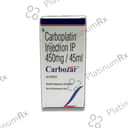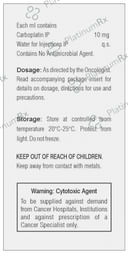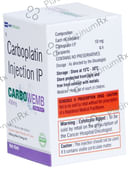Carboplatin
Uses
Carboplatin is used in the treatment of ovarian cancer and small cell lung cancer.
How it Works
How Carboplatin works Carboplatin is an anti-cancer medication that functions by damaging the genetic material (DNA and RNA) of cancer cells, thereby inhibiting their growth and multiplication.
Side Effects
Common side effects of Carboplatin include nausea, vomiting, anemia (low red blood cell count), low blood platelets, increased liver enzymes, decreased white blood cell count (neutrophils), peripheral neuropathy (tingling and numbness in the feet and hands), diarrhea, weakness, hair loss, changes in taste, constipation, decreased white blood cell count (lymphocytes), infection, bleeding, need for transfusions, pain, sensory disturbances, central nervous system problems, visual disturbances, ototoxicity, decreased creatinine clearance, increased creatinine levels in the blood, increased blood urea, elevated alkaline phosphatase levels in the blood, increased aspartate aminotransferase, electrolyte imbalance, hypersensitivity, skin disorders, and urogenital disorders.
Expert Advice
- It is administered as an injection into the veins.
- This procedure is conducted under the supervision of a doctor.
Other Combinations
Related Medications
Carboplatin 450mg

₹4,450

₹2,031.8
MRP ₹2,477.8
Carboplatin 450mg

₹2,083.3

₹2,031.8
MRP ₹2,477.8
Carboplatin 450mg

₹2,787

₹2,031.8
MRP ₹2,477.8
Carboplatin 450mg

₹2,433

₹2,031.8
MRP ₹2,477.8
Carboplatin 450mg

₹1,795

₹2,031.8
MRP ₹2,477.8
Carboplatin 450mg

₹2,330

₹2,031.8
MRP ₹2,477.8
Carboplatin 450mg

₹2,333

₹2,031.8
MRP ₹2,477.8
Carboplatin 450mg

₹2,333.2

₹2,031.8
MRP ₹2,477.8
Carboplatin 450mg

₹2,705

₹2,031.8
MRP ₹2,477.8
Carboplatin 450mg

₹2,517

₹2,031.8
MRP ₹2,477.8
Carboplatin 450mg

₹2,333.2

₹2,031.8
MRP ₹2,477.8
Carboplatin 450mg

₹2,750

₹2,031.8
MRP ₹2,477.8
Carboplatin 150mg

₹885

₹724.2
MRP ₹992
Carboplatin 150mg

₹795

₹724.2
MRP ₹992
Carboplatin 150mg

₹1,490

₹724.2
MRP ₹992
Carboplatin 150mg

₹928.1

₹724.2
MRP ₹992
Carboplatin 150mg

₹797

₹724.2
MRP ₹992
Carboplatin 150mg

₹678.1

₹724.2
MRP ₹992
Carboplatin 150mg

₹870

₹724.2
MRP ₹992
Carboplatin 150mg

₹870

₹724.2
MRP ₹992
Carboplatin 150mg

₹880

₹724.2
MRP ₹992
Carboplatin 150mg

₹822.9

₹724.2
MRP ₹992
Carboplatin 150mg

₹992

₹724.2
MRP ₹992
Carboplatin 150mg

₹860

₹724.2
MRP ₹992
Carboplatin 10mg

₹2,976.6